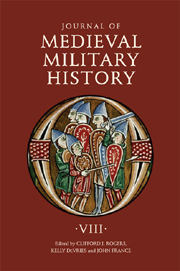Book contents
- Frontmatter
- Contents
- 1 People against Mercenaries: The Capuchins in Southern Gaul
- 2 The Last Italian Expedition of Henry IV: Re-reading the Vita Mathildis of Donizone of Canossa
- 3 Jaime I of Aragon: Child and Master of the Spanish Reconquest
- 4 Numbers in Mongol Warfare
- 5 Battlefield Medicine in Wolfram's Parzival
- 6 Battle-Seeking, Battle-Avoiding or perhaps just Battle-Willing? Applying the Gillingham Paradigm to Enrique II of Castile
- 7 Outrance and Plaisance
- 8 Guns and Goddams: Was there a Military Revolution in Lancastrian Normandy 1415–50?
- The Name of the Siege Engine trebuchet: Etymology and History in Medieval France and Britain
- Journal of Medieval Military History 1477–545
4 - Numbers in Mongol Warfare
Published online by Cambridge University Press: 12 September 2012
- Frontmatter
- Contents
- 1 People against Mercenaries: The Capuchins in Southern Gaul
- 2 The Last Italian Expedition of Henry IV: Re-reading the Vita Mathildis of Donizone of Canossa
- 3 Jaime I of Aragon: Child and Master of the Spanish Reconquest
- 4 Numbers in Mongol Warfare
- 5 Battlefield Medicine in Wolfram's Parzival
- 6 Battle-Seeking, Battle-Avoiding or perhaps just Battle-Willing? Applying the Gillingham Paradigm to Enrique II of Castile
- 7 Outrance and Plaisance
- 8 Guns and Goddams: Was there a Military Revolution in Lancastrian Normandy 1415–50?
- The Name of the Siege Engine trebuchet: Etymology and History in Medieval France and Britain
- Journal of Medieval Military History 1477–545
Summary
The Mongols created the largest land empire known to history during the thirteenth century. It was an empire created by means of military conquest. The military successes of the Mongols are now generally seen as a result of superior weaponry, tactics, and organization. Historians have rejected the older view that the Mongols greatly outnumbered their foes, holding instead that the Mongols were in fact generally outnumbered. The Mongol run of conquests took them all the way into Central Europe. At Mohi in 1241, they defeated a Hungarian army. It is not known how large the armies were at Mohi, but it has been estimated that each side had more than 50,000 men. Such numbers are hard to reconcile with the reality of the medieval world where the King of France and the Emperor of Germany, two of the most powerful men in Europe, each struggled to get more than 2,000 horsemen and 10,000 men in total on a single battlefield in 1214. When Edward I of England, another powerful European ruler, invaded Scotland in 1300 he fielded 700 horsemen. He aimed to raise 16,000 infantry, but only managed to get 9,000 and this total quickly dropped to 6,000. It seems unlikely Hungary could field an army many times larger than those fielded by the rulers of Germany, France, or England. It will be argued in this article that the Mongol forces were in fact much smaller than generally accepted, though they were larger on the battlefield than the enemy armies. To construct the argument, the numbers of the Mongol armies and their foes will be considered at the various stages of the Mongol westward advance.
- Type
- Chapter
- Information
- Journal of Medieval Military History , pp. 109 - 117Publisher: Boydell & BrewerPrint publication year: 2010

